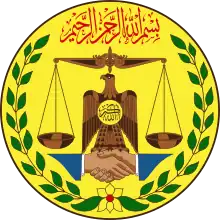Somaliland Armed Forces
The Somaliland National Armed Forces (Somali: Ciidamada Qalabka Sida ee Soomaaliland; Arabic: القوات المسلحة الصوماليلاندية, romanized: alquaat almusalahat alsuwmalilandia) are the military services of the Republic of Somaliland. The Somaliland National Armed Forces consist of the Somaliland National Army, the Somaliland Coast Guard, the Somaliland Police Force, the Somaliland Custodial Corps, the Somaliland Immigration and Border Control and the Somaliland Fire Brigade. There is no air force.[3] The Armed Forces is under the command of President Muse Bihi Abdi, who is the Commander-in-chief. Minister of Defence Abdiqani Mohamoud Aateye is the designated minister that oversees the armed forces.
| Somaliland Armed Forces | |
|---|---|
| Ciidamada qalabka sida ee Soomaaliland (Somali) | |
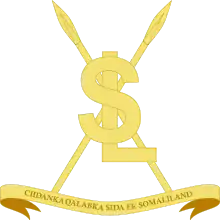 Somaliland Armed Forces emblem | |
 Somaliland Armed Forces flag | |
| Founded | 1993 |
| Service branches | Security and War time only:  Somaliland Custodial Corps Somaliland Custodial Corps |
| Headquarters | Hargeisa, Somaliland |
| Leadership | |
| Commander-in-chief | |
| Minister of Defence | Abdiqani Mohamoud Aateye |
| Chief of Staff | |
| Personnel | |
| Fit for military service | 300,000, age 15–49 |
| Reaching military age annually | 500,000 |
| Active personnel | 36,000 est. [1] |
| Expenditures | |
| Budget | $115 million (2019)[2] |
| Percent of GDP | 0.6% |
| Industry | |
| Foreign suppliers | |
| Related articles | |
| History | Military history of Somaliland |
| Ranks | Military ranks of Somaliland |
Somaliland has 45 T-54/55 tanks and, 20 armoured fighting vehicles, 50 rocket projectors, and has 12 pieces of artillery in its national army.
The estimated total strength of the Somaliland is estimated by 100,000 men. There are fewer than 6,000 men and women working for the Somaliland police force overall. The Special Police Unit (SPU), which protects foreign organizations and individuals who work for them, and the Rapid Response Units (RRU), which are specialized counterterrorism forces, are both housed inside the police force. Somaliland has 7 defender class boats and 1 coast guard vessels in its coast guard, and The coast guard of Somaliland numbers a few hundred in personnel.[4]
Somaliland spends $115 million budget on its armed forces, its largest government expenditure.[2] Due to a United Nations arms embargo on Somalia, the state is not allowed to procure weapons.[5]
History
Protectorate period
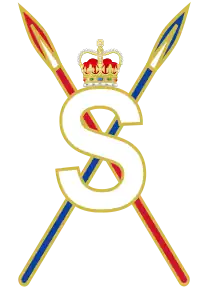
In 1914, the Somaliland Camel Corps was formed in British Somaliland and saw service before, during, and after the Italian invasion of the territory during World War II.[6]
In 1942, the Somaliland Scouts were tasked with defending the reserve.[7]
Independence and Union with Somalia
Somaliland became independent on 26 June 1960 as the State of Somaliland, and the Trust Territory of Somalia (the former Italian Somaliland) followed suit five days later. On 1 July 1960, the two territories united to form the Somali Republic.[8]
After independence, the Somaliland Scouts merged with the former Dervishes to form the 5,000 strong Somali National Army.
War of Independence
In 1981, the Somali National Movement was one of the first rebel groups to form in the country.[9]
Then Somali dictator Siad Barre accused them of being separatist groups and ordered the extermination of the Isaaq tribe,[10][11] to which the rebel group belonged. The movement fought a guerrilla war in the northwest of the country with the aim of overthrowing and replacing the military government.[12] After the dictator's defeat and special developments in 1991, the Somali sultans decided to abolish unity in 1960 and declared Somaliland an independent state.
Restoration of sovereignty
In 1991, after Somaliland reasserted its sovereignty, the new government faced great problems with armed groups and armed clans, who were boycotting roads to earn a living.[13][14]
The new government launched the Somaliland peace process jointly with the Somali National Movement. The communities in Somaliland negotiated what led to the Great Reconciliation Conference in Borama in 1993 which allowed the transfer of power from the Somali National Movement.[15] An interim government for a new civil administration, paving the way for democratic governance and stability.[15]
After a civilian government led by Muhammad Haji Ibrahim Egal disarmed armed clans and armed groups and recruited armed forces from all over Somaliland.
The Armed Forces of Somaliland was officially established on 2 February 1994.[16]
Border War
In 1998 Puntland State of Somalia claimed Somaliland territory on the basis of clan kinship with some Somaliland communities in the eastern regions of Sool and Sanaag. Which led to tribal and armed conflicts, as a result, The armed forces of Somaliland withdrew from some cities in the eastern regions to avoid casualties until 2007 when the Somaliland communities in the eastern regions demanded that they intervene.
Commanders
The Chief of the General Staff (Somali: Taliyaha Guud ee Ciidanka) is the head of the General Staff and the highest ranking officer of the Somaliland Armed Forces. He is appointed by the President of Somaliland, who holds the position of Commander-in-Chief and the head of the Somaliland Armed Forces. The current Chief of the General Staff is Major general Nuh Ismail Tani.
Army
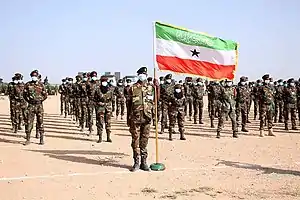
Personnel
The Somaliland army has long operated without a formal rank structure. However, in December 2012, Somaliland defense ministry announced that a chain of command had been developed and which was implemented in January 2013.[3]
Equipment
When the former Somali dictator Siad Barre was ousted in 1991, Somaliland inherited the military equipment, hardware and facilities that was left behind by the previous Somali Democratic Republic.[5]
Due to a United Nations arms embargo on Somalia, which the semi-autonomous Somaliland region is internationally recognized as being a part of, the territory is not allowed to purchase weapons. Consequently, military officials from the region rely on repairing and modifying old equipment. Some also claim that weapons are at times delivered from Ethiopia and Yemen via the port of Berbera.[5]
Regular Somaliland soldiers have been seen with SKS carbines (for parades) and various versions of the AK-47.[17]
Vehicles and Equipment

- Tanks
- Armoured Personnel Carriers
- Transport Vehicles
 Iveco LMV (4x4)
Iveco LMV (4x4) Renault GBC-180 (6×6)
Renault GBC-180 (6×6) M939 Truck (6×6)
M939 Truck (6×6) Toyota Landcruiser J79
Toyota Landcruiser J79 Toyota Hilux
Toyota Hilux Nissan Frontier
Nissan Frontier Ford F350 (Armoured Gun Truck)
Ford F350 (Armoured Gun Truck) Humvee
Humvee
- Self-Propelled Artillery
 BM-21 Grad (Multiple Rocket Launcher - 122mm)
BM-21 Grad (Multiple Rocket Launcher - 122mm) Humvee (Multiple Rocket Launcher)
Humvee (Multiple Rocket Launcher) Type 63 multiple rocket launcher (107mm)
Type 63 multiple rocket launcher (107mm)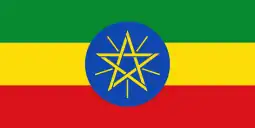 Toyota mounted 4 barrel (122mm-multiple rocket launcher)
Toyota mounted 4 barrel (122mm-multiple rocket launcher)
- Towed Artillery
- Mortar
- Anti-Aircraft Gun
 ZU-23-2 (Twin-barrelled anti-aircraft gun - 23mm)
ZU-23-2 (Twin-barrelled anti-aircraft gun - 23mm) ZPU-4 (Quad-barrelled anti-aircraft gun - 14.5mm)
ZPU-4 (Quad-barrelled anti-aircraft gun - 14.5mm)
Coast Guard

The Somaliland Coast Guard (Somali: Ciidanka Bada ee Somaliland) was formed in 2009.[5] The headquarters is located in the coastal town of Berbera; a diving center run by foreign divers who train the Somaliland coast guard is also located there. The coast guard operates with small speedboats mounted with guns.[5] Much of this equipment was provided by the United Kingdom, in an effort to combat piracy.[3]
Ranks
- Officers
| Rank group | General / flag officers | Senior officers | Junior officers | Officer cadet | ||||||||||||||||||||||||||||||||
|---|---|---|---|---|---|---|---|---|---|---|---|---|---|---|---|---|---|---|---|---|---|---|---|---|---|---|---|---|---|---|---|---|---|---|---|---|
 |
 |
 |
 |
 |
 |
 |
 |
 |
||||||||||||||||||||||||||||
| Lieutenant general Sareeye Guud |
Major general Sareeye Gaas |
Brigadier general Sareeye Guuto |
Colonel Gashaanle Sare |
Lieutenant colonel Gashaanle Dhexe |
Major Gashaanle |
Captain Dhamme |
First lieutenant Laba Xídígle |
Second lieutenant Xídígle |
||||||||||||||||||||||||||||
- Enlisted
| Rank group | Senior NCOs | Junior NCOs | Enlisted | |||||||||||||||||||||||||||||||||
|---|---|---|---|---|---|---|---|---|---|---|---|---|---|---|---|---|---|---|---|---|---|---|---|---|---|---|---|---|---|---|---|---|---|---|---|---|
 |
 |
 |
 |
 |
 |
 |
 | |||||||||||||||||||||||||||||
| Chief warrant officer Musharax sarkaal |
Warrant officer class 1 Sadex xarígle |
Warrant officer class 2 Laba xarígle |
Warrant officer class 3 Xarígle |
Sergeant Sadex alífle |
Corporal Laba alífle |
Lance corporal Alífle |
Private (or equivalent) Dable | |||||||||||||||||||||||||||||
Gallery
 Somaliland Patrol Boat of the Somaliland Coast Guard
Somaliland Patrol Boat of the Somaliland Coast Guard Somaliland T-55 main battle tank
Somaliland T-55 main battle tank Somaliland Fiat armored car
Somaliland Fiat armored car.jpg.webp) Somaliland BM-21 Grad
Somaliland BM-21 Grad
See also
References
- http://indepthafrica.com/somaliland-after-two-decades-the-armed-forces-come-to-age/#.URr3NqWpN8w
- Rubin, Michael (7 March 2019). "Somaliland – Key to Winning America's Longest War". www.realcleardefense.com. Retrieved 2020-03-03.
- Somaliland Sun (27 November 2012). "Somaliland: After Two Decades the Armed Forces Come to Age". somalilandsun.com. Somaliland Sun. Retrieved 28 September 2020.
- Horton, Micheal (November 2019). "How Somaliland Combats al-Shabaab". CTC Sentinel. 12 (10): 24. Archived from the original on 27 March 2022. Retrieved 15 May 2023.
- Hussein, Abdi (August 13, 2011). "Somalilands Military Is A Shadow of the Past". SomaliaReport. Retrieved August 13, 2011.
- Metz 1993, p. 199-200.
- Metz et al. 1993, "The Warrior Tradition and Development of a National Army," in Somalia: A Country Study.
- "Somalia: A Country Study – Chapter 5: National Security" (PDF). Library of Congress. c. 1981. Archived from the original on 4 October 2012.
{{cite web}}: CS1 maint: unfit URL (link) - United States Bureau of Citizenship and Immigration Services, Resource Information Center. "Somalia: Somali National Movement from its inception through the present".
- Ingiriis, Mohamed Haji (2016-07-02). ""We Swallowed the State as the State Swallowed Us": The Genesis, Genealogies, and Geographies of Genocides in Somalia". African Security. 9 (3): 237–258. doi:10.1080/19392206.2016.1208475. ISSN 1939-2206. S2CID 148145948.
- Mullin, Chris (1 October 2010). A View From The Foothills: The Diaries of Chris Mullin. Profile Books. p. 504. ISBN 978-1-84765-186-0.
Siad barre's holocaust.
- Balthasar, Dominik (2017-07-26). "State-making at Gunpoint: The Role of Violent Conflict in Somaliland's March to Statehood". Civil Wars. 19: 65–86. doi:10.1080/13698249.2017.1343411. ISSN 1369-8249. S2CID 149160219.
- "Taliyaha Ciidanka Qaranka Oo Sharraxay Taariikhda iyo Waxqabadka Ciidanka". 3 February 2018.
- "Wax ka baro taariikhda ciidanka qaranka somaliland. | ToggaHerer".
- Ali, Mohamud Omar; Mohammed, Koss; Walls, Michael (2007-12-31). "Peace in Somaliland: An Indigenous Approach to State-building". Africa Portal. Retrieved 2020-08-27.
- "Somaliland Military Law".
- Forberg, Ekkehard and Ulf Terlinden. "Small Arms in Somaliland: Their Role and Diffusion" Berlin Information-center for Transatlantic Study (BITS). March 1999. Retrieved February 13, 2013.



